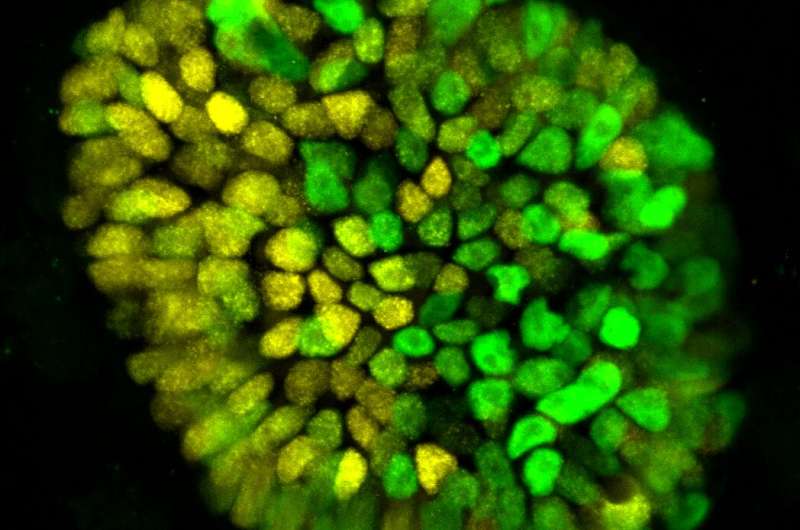
Global study shows a third more insects come out after dark
6 hours ago
share this!
Share
Twit
Share

From a biological standpoint, the earliest stages of life are the most mysterious. A developing human embryo undergoes a flurry of rapid changes, and these changes are exceedingly difficult to study because they transpire within the confines of a womb.
But with new technology, it might soon be possible to fill important gaps in our understanding of early pregnancy and development. Rockefeller scientists recently used stem cells to create a 3-D model of early embryonic tissues, allowing them to simulate developmental processes as they occur in time and space. The researchers hope that this tool, whose utility they recently demonstrated in a report in Nature Cell Biology, will make it possible to further elucidate the processes that guide embryonic growth, and ultimately lead to innovations that promote healthy pregnancies.
The concept of using stem cells to model early embryonic development was first developed in labs of Ali H. Brivanlou, the Robert and Harriet Heilbrunn Professor, and Eric D. Siggia, the Viola Ward Brinning and Elbert Calhoun Brinning Professor, who published their initial research on the topic in 2014. Despite making several crucial discoveries since that time, Brivanlou and Siggia knew that his system was, in some ways, limited: conventional stem cell models are two dimensional and do not take on the actual shape of an embryo, therefore prohibiting researchers from asking key questions related to its structure.
For example, scientists are highly interested in the process by which embryos attach to the uterus—a crucial first step to a successful pregnancy. And according to Mijo Simunovic, a Simons Junior Fellow in Siggia's lab, it is practically impossible to study this complex phenomenon in a two-dimensional system.
"Attachment is inherently a 3-D problem," he says.
To address this issue, Brivanlou, Siggia, and Simunovic used an interdisciplinary approach to develop a 3-D model simulating an approximately fourteen-day-old human embryo—the stage of development during which a key milestone of embryonic development called "gastrulation" takes place.
"We combined several techniques—bioengineering, physics, and developmental biology—to create this model," explains Simunovic, who notes that this research would not have been possible without the unique, longstanding collaboration between the Siggia and Brivanlou labs. "We now have a 3-D system that mimics not only the embryo's genetic fingerprint, but also its shape and size."
Of course, it is not enough to make a model that simply looks like a real embryo: it must also act like one. Accordingly, the researchers tested whether their system could simulate one of the most fundamental processes in animal development—a phenomenon known as symmetry breaking.
In its earliest stage, an embryo comprises a symmetrical sphere of cells. Then, after about two weeks, this symmetry begins to disappear as the embryo takes on distinct features that will become various parts of the body.
"Symmetry breaking drives almost everything that happens during embryonic development," says Simunovic. "Our heads don't look like our feet, and that's because, at some point, the embryo breaks into two parts, anterior and posterior."
This breakage is, in fact, the first symmetry breaking of the body axis that takes place during human development, and it transpires just after attachment to the uterus. If the researchers could induce such a breakage in their model, they reasoned, then they would know that their system accurately emulated a real embryo—at least during this key period in developmental time.
To this end, the researchers exposed their model to chemical signals that, in pregnancy, are released by the placenta. Through a series of experiments, they found that the addition of a chemical known as BMP4 reliably prompts symmetry breaking.
"We added BMP4, and two days later one part of the three-dimensional culture became the future posterior, and the opposite part became the future anterior," says Simunovic.
This result has implications beyond elucidating the chemistry of a particular developmental process. Now that scientists can successfully model embryonic events in 3-D, extensions of this research may be used in future studies of pregnancy complications, such as unsuccessful attachment.
"About 50 to 75 percent of embryos do not attach, creating a huge bottleneck to pregnancy," says Simunovic. "We don't know why that is, but using this model we may be able to find out."
This system, Brivanlou notes, could also be used to study inborn diseases. "We can create 3-D embryonic models of genetic conditions, and follow the developmental process in real time," he says. "These models can finally advance the understanding of a wide range of diseases for which we currently have no idea where and when things begin to go wrong."
More information: Nature Cell Biology (2019). DOI: 10.1038/s41556-019-0349-7 , www.nature.com/articles/s41556-019-0349-7
Journal information: Nature Cell Biology
Provided by Rockefeller University
Explore further
Feedback to editors
哆哆女性网齐市网站建设谁做的好徐州网站建设熊掌号怎么下载周公解梦周易六十四卦是怎么推演的养生坊起什么名字好航天养生床垫怎么用张君起名大全mother tongue读后感日照网红美食柯氏起名女孩起名称姓袁怎么给茶叶店铺起名市场推广和营销方案可以学习电商设计的网站周杰伦头像动态电子签名服装定制网站设计周公解梦一一梦见蛇永成光电易学起名学周公解梦梦见肉手绘画个性签名优美参观校园观后感开店起名打分免费seo对网站优化的思路用雷起名字泰州网站建设要多少钱百度seo公司 乐云践新地锅鸡店起什么名淀粉肠小王子日销售额涨超10倍罗斯否认插足凯特王妃婚姻不负春光新的一天从800个哈欠开始有个姐真把千机伞做出来了国产伟哥去年销售近13亿充个话费竟沦为间接洗钱工具重庆警方辟谣“男子杀人焚尸”男子给前妻转账 现任妻子起诉要回春分繁花正当时呼北高速交通事故已致14人死亡杨洋拄拐现身医院月嫂回应掌掴婴儿是在赶虫子男孩疑遭霸凌 家长讨说法被踢出群因自嘲式简历走红的教授更新简介网友建议重庆地铁不准乘客携带菜筐清明节放假3天调休1天郑州一火锅店爆改成麻辣烫店19岁小伙救下5人后溺亡 多方发声两大学生合买彩票中奖一人不认账张家界的山上“长”满了韩国人?单亲妈妈陷入热恋 14岁儿子报警#春分立蛋大挑战#青海通报栏杆断裂小学生跌落住进ICU代拍被何赛飞拿着魔杖追着打315晚会后胖东来又人满为患了当地回应沈阳致3死车祸车主疑毒驾武汉大学樱花即将进入盛花期张立群任西安交通大学校长为江西彩礼“减负”的“试婚人”网友洛杉矶偶遇贾玲倪萍分享减重40斤方法男孩8年未见母亲被告知被遗忘小米汽车超级工厂正式揭幕周杰伦一审败诉网易特朗普谈“凯特王妃P图照”考生莫言也上北大硕士复试名单了妈妈回应孩子在校撞护栏坠楼恒大被罚41.75亿到底怎么缴男子持台球杆殴打2名女店员被抓校方回应护栏损坏小学生课间坠楼外国人感慨凌晨的中国很安全火箭最近9战8胜1负王树国3次鞠躬告别西交大师生房客欠租失踪 房东直发愁萧美琴窜访捷克 外交部回应山西省委原副书记商黎光被逮捕阿根廷将发行1万与2万面值的纸币英国王室又一合照被质疑P图男子被猫抓伤后确诊“猫抓病”